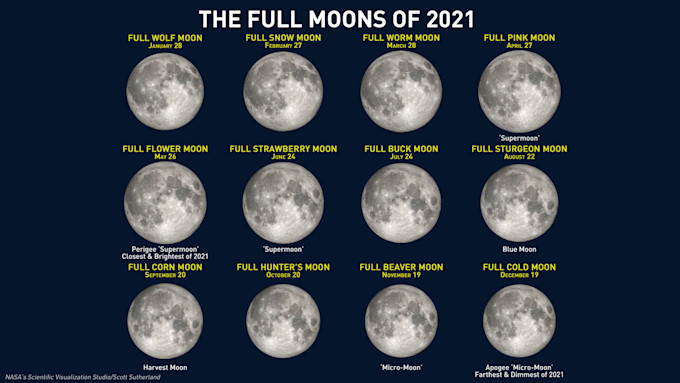WHAT IS THE SNOW MOON?
According to The Old Farmer's Almanac, each Full Moon of the year goes by several names. The February Full Moon is most commonly called the Snow Moon. Other names include Bear Moon, Eagle Moon, Raccoon Moon, Groundhog Moon, and Hunger Moon.
As for why February's Moon is called the Snow Moon, the Almanac says:
"February is typically a time of heavy snowfall."

This graphic collects all the relevant data about each Full Moon of 2021, including their popular names, whether they are a 'super' or 'micro' Moon, a perigee or apogee Full Moon, and whether they are remarkable in some other way (Blue Moon or Harvest Moon). Credit: NASA's Scientific Visualization Studio/Scott Sutherland
Most of these Full Moon names are simplifications or loose translations of names and phrases from First Nations peoples. According to Western Washington University's Spanel Planetarium, many First Nations tribes had names for the February Full Moon. Some named them after animals, such as the goose (the Haida and the Omaha), the rabbit (the Potawatomi), the crow (the Shawnee), the coyote (the Shoshone), or the black bear (the Tlingit). There are references to cold (the Lakota and Wishram), ice or frost (the Algonquin and Arapaho), and sleet (the Comanche). The Kalapuya of the Pacific Northwest referred to it as "atchiulartadsh" — which translates to "out of food" — and could be a possible reference to 'Hunger Moon'.
Does it live up to the name Snow Moon, though?
There is certainly an abundance of snow on the ground across Canada right now. Also, plenty of that snow fell during storms that swept across parts of the country during the month of February.

According to Environment and Climate Change Canada, however, at least over the past 30 years, January has been the month of the year when most Canadians see the highest snowfall amounts.
"February may not be the month where the most snow falls in a year, but because it comes at the end of the season, and at a time when temperatures for most places average below zero, you probably see more snow on the ground since you've had your best chance to build up snowpack," says Weather Network meteorologist Michael Carter.
















